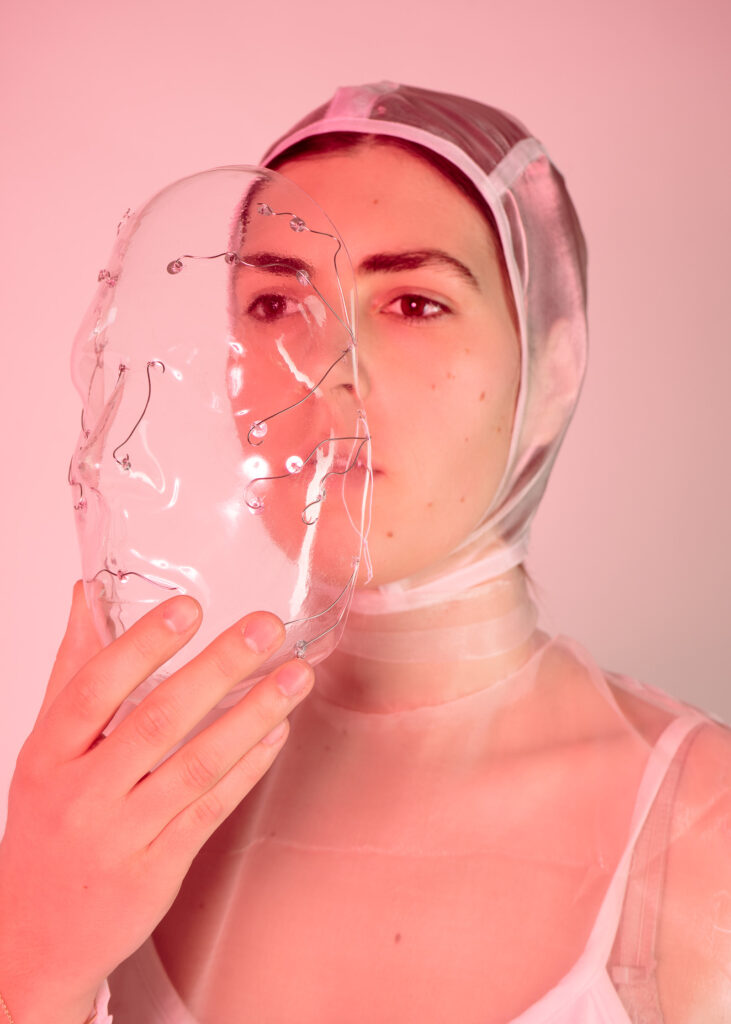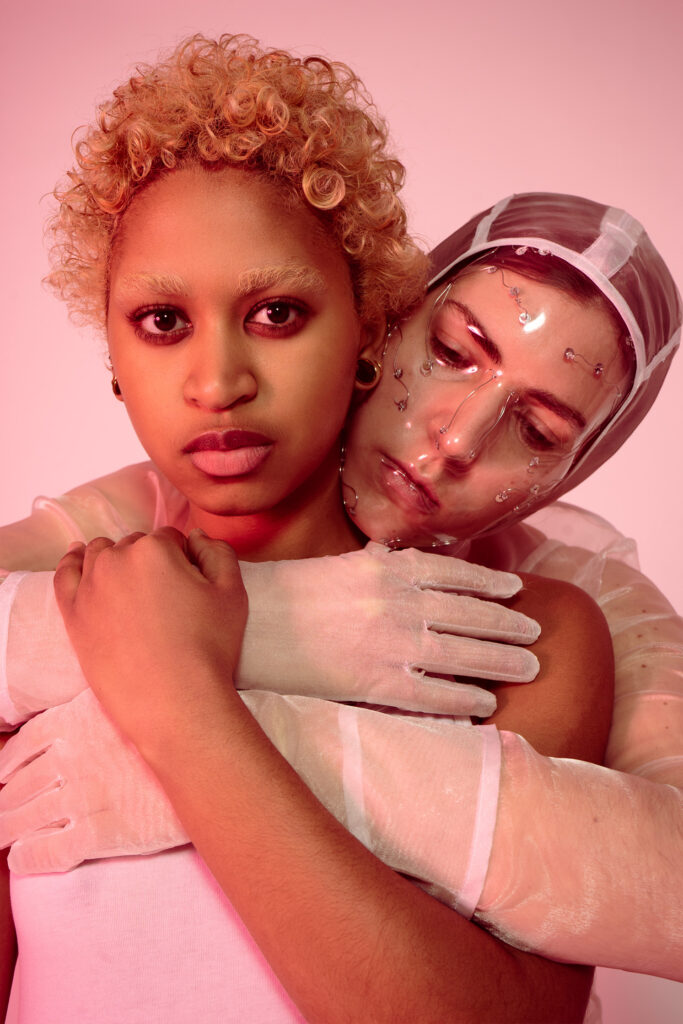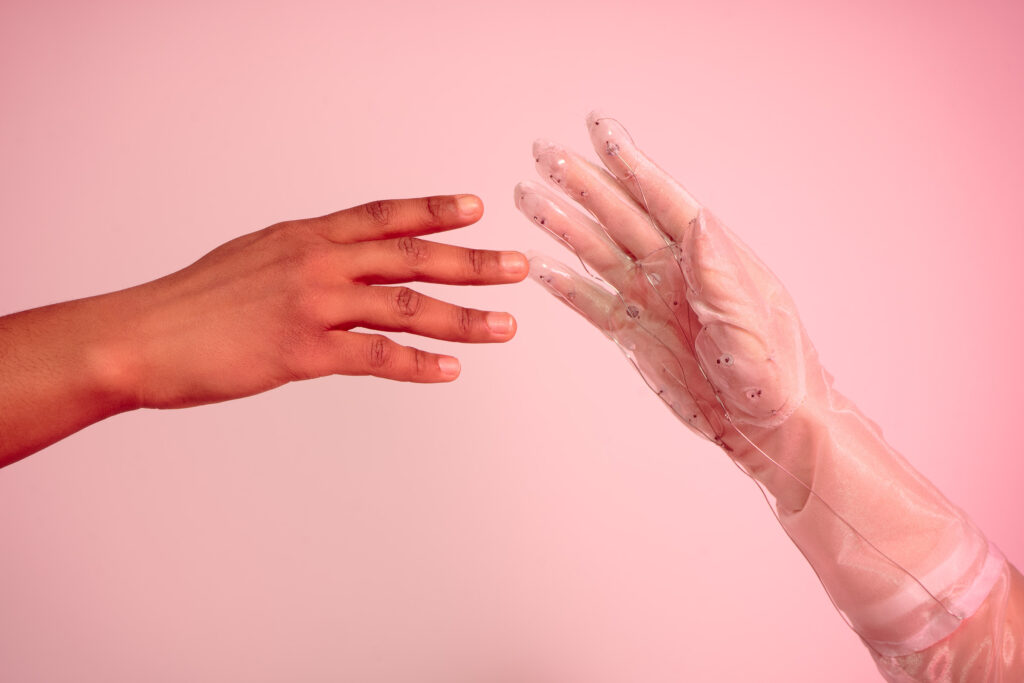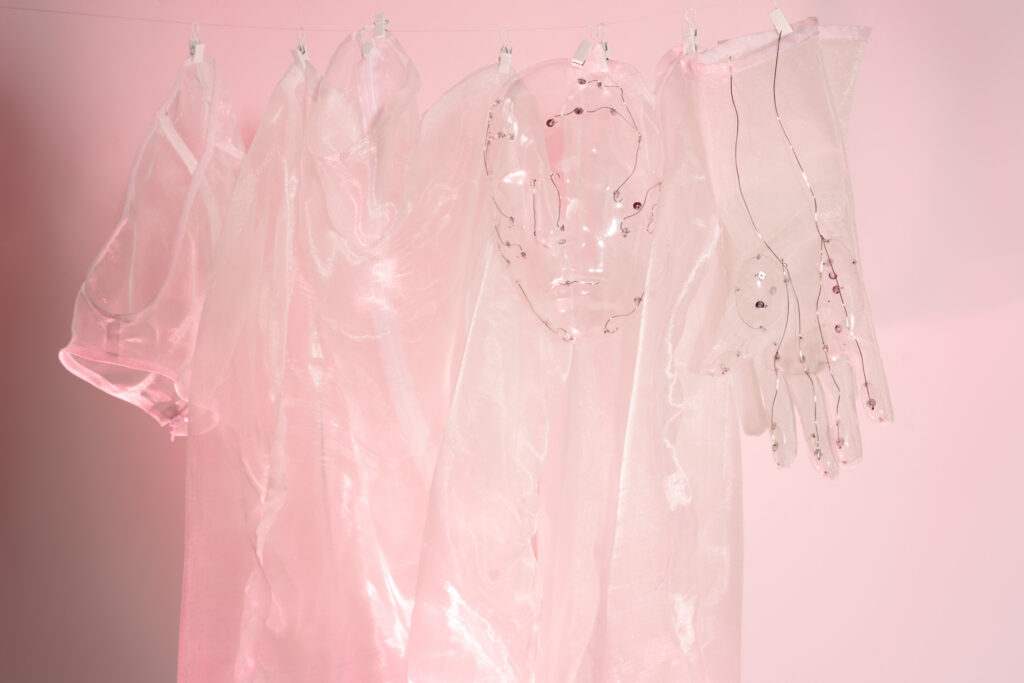Deutsch
English
SZENARIO
Seit 2020 wissen wir, wie schnell man durch ein Virus voneinander getrennt werden kann. Eine Umarmung, ein Kuss auf die Wange, ein liebevolles Streichen über den Rücken – für viele ganz normal im Alltag, heute nicht mehr möglich. Dabei ist körperliche Nähe nicht nur ein schöne Art seine Liebe auszudrücken, sondern Grundvo- raussetzung für soziales Leben überhaupt. Doch was ist die Folge von anhaltender physischer Distanz? Das Hor- mon Oxytocin, das bei zwischenmenschlichem und kör- perlichem Kontakt ausgeschüttet wird, ist wesentlich an der Entwicklung von Empathie beteiligt und fördert so mittelbar auch unser Zusammenleben. Gleichzeitig hat es einen positiven Einfluss auf unser Immunsystem und andere Prozesse in unserem Körper. Wenn Körpernähe und damit auch Oxytocin ausbleiben, können wir das aufgrund der von uns entwickelten Wahrnehmungs- und Verhaltensweisen zwar noch eine Weile kompensieren. Wird diese Mangelsituation† jedoch zu einem Dauerzu- stand, drohen wir auch unseren sozialen Zusammenhalt zu verlieren.
Forschungsfrage:
Wie kann körperliche Nähe erlebt werden, auch wenn die direkte Berührung nicht möglich ist?
KONZEPT
Dieser Schutzanzug bietet viel mehr als nur Schutz. Bei ihm geht es nämlich um unser natürliches Bedürfnis nach Berührung. In einer Gesellschaft der verhinderten Kontakte brauchen wir eine neue Ausrichtung auf das, was uns zusammenhält. Dabei kann Berührung nicht nur als eine Handlung, sondern vielmehr als ein Kommuni- kationsmedium gesehen werden, was fester Bestandteil in einer von Digitalisierung dominierten Welt sein sollte. Der technische Fokus liegt auf der Wiederbelebung der sensorischen Wahrnehmung. Wir sind schon zu lange physisch voneinander getrennt. Es wird Zeit, dass das Miteinander, auch wenn es nur imaginär im virtuellen Raum stattfindet, wieder zu einer sensorischen Realität wird.
Der Anzug besteht aus einem dünnen, sehr feinen technischen Stoff, der zugleich virenundurchlässig ist. Berührungen sind durch ihn fast genauso unmittelbar
zu spüren wie bei direktem Hautkontakt. An besonders berührungssensitiven Körperstellen ist zusätzlich ein atmungsaktives Plastik eingearbeitet, das auf der Auflenfläche mit kapazitiven Sensoren und innen mit Vibrationsmotoren versehen ist. Wird die Oberfläche dieser Partien berührt, aktiviert der Sensor die Vibrationsmotoren auf der Innenseite, und es entsteht ein aufregendes Gefühl auf der Haut. So können nicht nur verloren geglaubte Empfindungen wieder lebendig werden, sondern es eröffnen sich auch ganz neue Seiten des taktilen Erlebens.
SCENARIO
Since 2020, we have known how quickly people can be separated from each other by a virus. A hug, a kiss on the cheek, an affectionate stroke across the back - for many, this is a normal part of everyday life, but no longer possible today. Physical closeness is not only a beautiful way to express love, but a basic requirement for social life in general. But what is the consequence of prolonged physical distance? The hormone oxytocin, which is released during interpersonal and physical contact, plays a major role in the development of empathy and thus indirectly promotes our coexistence. At the same time, it has a positive influence on our immune system and other processes in our body. If there is a lack of physical closeness and thus also of oxytocin, we can compensate for this for a while on the basis of the perceptual and behavioral patterns we have developed. However, if this deficiency† becomes a permanent condition, we also risk losing our social cohesion.
Research question:
How can physical closeness be experienced even when direct touch is not possible?
CONCEPT
This protective suit offers much more than just protection. It is in fact about our natural need for touch. In a society of prevented contact, we need a new focus on what holds us together. Touch can be seen not only as an action, but rather as a medium of communication, which should be an integral part of a world dominated by digitalization. The technical focus is on reviving sensory perception. We have been physically separated from each other for too long. It's time that togetherness, even if it's only imaginary in virtual space, becomes a sensory reality again.
The suit is made of a thin, very fine technical fabric that is also impermeable to viruses. Touch can be felt through it almost as directly
as with direct skin contact. In areas of the body that are particularly sensitive to touch, a breathable plastic is also incorporated, which is equipped with capacitive sensors on the surface and vibration motors on the inside. If the surface of these parts is touched, the sensor activates the vibration motors on the inside, and an exciting feeling is created on the skin. Not only can sensations that were thought to be lost come to life again, but completely new sides of tactile experience are also opened up.







